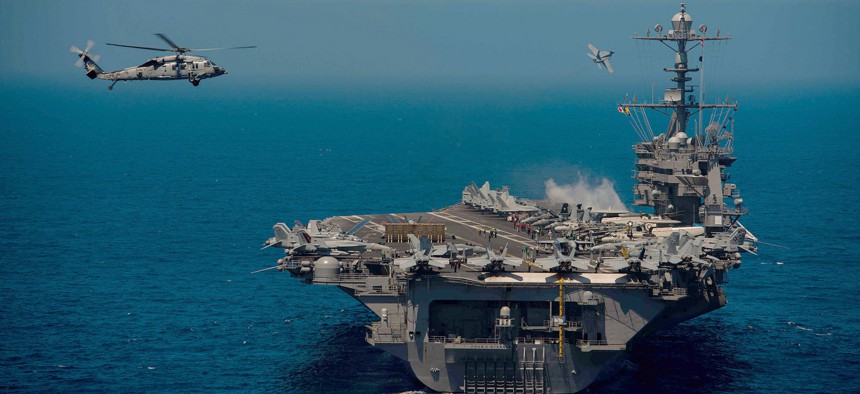
An MH-60S Knight Hawk helicopter attached to the Chargers of Helicopter Sea Combat Squadron (HSC) 14 performs plane guard operations near the aircraft carrier USS John C. Stennis. U.S. Navy photo by Mass Communication Specialist 3rd Class Ignacio D. Perez
America's Allies Want More From the US
The next president has to figure out how to give it to them – more presence, more forces, more aid.
During the past several years, U.S. allies got a “reset” and a “rebalance,” but what they really need and want is reassurance. During our time in the Obama administration, we saw this virtually every day –requests for more high-level attention, greater assistance and spending, stronger military presence and more assets, and deeper diplomatic engagement. But in an era shaped by the Iran nuclear deal, a resurgent Russia, and an aggressive China, American officials are scrambling to figure out what more they can do, and what, if anything, would be enough to satisfy our partners in the Middle East, Europe, and Asia.
The specific roots of these stresses vary by region, but the general drivers are the same. America’s partners fear the shifting security and political dynamics in their neighborhoods. They question the reliability of decades-old security agreements and international institutions created for different challenges in a different era. And they have taken note of growing U.S. wariness for international engagements.
Our allies’ requests have similarities as well. Generally speaking, our partners want a large and well-equipped U.S. military presence in their neighborhood, ISR support, access to technology, high-end military platforms, and as many U.S. Cabinet members as possible coming through their capitals, especially if those visits come with concrete deliverables.
In Asia, nervous allies welcome Obama’s rebalance strategy, but ask whether its implementation matches its ambition. They worry that the U.S. buildup in the Pacific is too slow to match Beijing’s military modernization and its expanding territorial claims in the South China Sea. They want a stronger U.S. naval presence, a maritime coalition of the willing, clarity on the conditions under which the U.S. would act militarily, and heavier engagement in regional institutions like ASEAN. They also want the administration to finalize the Trans-Pacific Partnership (TPP) after five long years of negotiations.
Meanwhile, European allies confronted with a growing Russian threat regard the Pacific with some jealousy. Still, U.S. military forces, which had been steadily moving out of Europe for more than two decades, have since the Ukraine crisis begun flowing back in. Starting last year, over 1,000 U.S. troops have been rotating throughout Eastern Europe to train and exercise with NATO counterparts. Coming soon are new stocks of prepositioned U.S. equipment, including heavy armor. These efforts are being funded by an additional $1 billion the Obama administration received last year as part of the “European Reassurance Initiative.”
Yet the Europeans know that most of these reassurance measures are temporary. With Russian President Vladimir Putin expected to stay in office at least through 2024, they are anxious to secure a permanent U.S. commitment (read: boots on the ground) with a heavier emphasis on deterrence.
In the Middle East, the Gulf states and Israel worry that the U.S. is rushing to accommodate Iran, and that the recent nuclear deal will lead to even more aggressive Iranian behavior. So the U.S. has shifted into reassurance overdrive: pouring resources into the region, sending cabinet-level officials on visits (Ash Carter was there two weeks ago, and John Kerry is there this week), working to maintain a robust military presence, trying to improve security cooperation with the Gulf states, and providing an unprecedented level of military capabilities (several recent arms sales have been the largest in U.S. history).
When one steps back to consider the demands of global reassurance, three conclusions stand out.
First, easing fully the anxieties of our allies would require a level of resources that would be very difficult to muster and even harder to maintain. Region by region, it is easy to see how the U.S. could add more military capabilities, sell more weapons, or get more diplomatically engaged.But the challenge for President Obama and his successor will be to do all this simultaneously, especially when the resources for reassurance are tighter. Just as the world is asking for more, the dynamic in Washington will leave us with less. Some reforms may be necessary – closing some outdated facilities overseas, or reducing the size of the U.S. Army – but that will make reassurance harder. The next President will have to be more creative as he or she seeks to balance competing demands in a way that is effective, realistic and sustainable. A good start would be acomprehensive review of U.S. force posture that would weigh allies’ requests for reassurance against America’s core national security interests and its resource constraints.
Second, the defense budget must rise. The size and shape of our armed forces are inadequate to meet today’s requirements. A good starting point would be to return to then-Defense Secretary Robert Gates’ 2012 budget proposal, which sought modest nominal-dollar increases through the next decade. The Pentagon must also be allowed to manage its own budget cuts.
Finally, though it is tempting to see the demands of global reassurance only as burdens, it is important to see the opportunity they present.
Despite all the talk of America’s decline or the limits of its power, no other country is as hotly wooed or enjoys such expectations from so many corners of the globe. Reflecting on the hundreds of meetings we had with foreign officials during our time in the Obama administration, we cannot think of a single one who asked for less of the United States. They all wanted more of our time, our attention, and our stuff. Few countries are demanding more from China, Russia or Iran — and we need to keep it that way.




